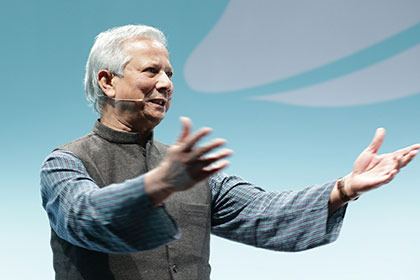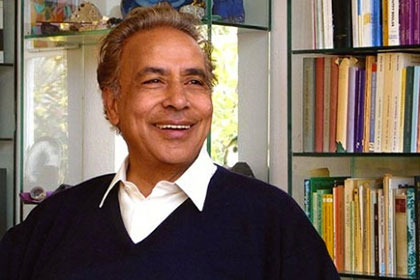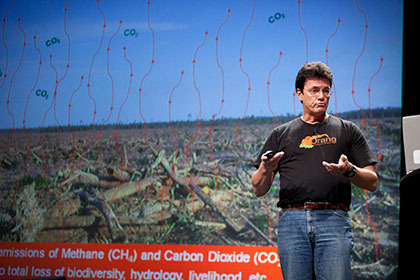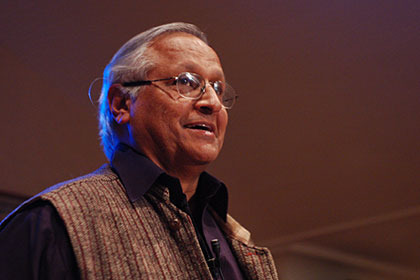Erik Qualman's Blog, page 656
July 17, 2012
Social Marketology: 5 Questions with Ric Dragon

One of the main complaints I hear when talking to companies about social marketing is lack of control. They don’t feel that their content distribution is systematic, they don’t understand their audience and influencers, and they don’t feel they are agile enough to deal with functional changes. Luckily, Ric Dragon presents a process approach to social media marketing in his new book Social Marketology: Improve Your Social Media Processes and Get Customers to Stay Forever. Ric is the CEO of DragonSearch, a regular speaker for Google at their Get Your Business Online seminars, a regular columnist for Marketing Land and Social Media Monthly. In anticipation of our Social Marketology webinar next week, we sat down with Ric for some Q and A.[image error]
What can readers expect to learn from reading Social Marketology?
There are two major aspects of the book: The first and most fundamental is that Social Marketology provides a framework for social media marketing. We can all get caught up in the constant and rapid changes taking place in the tools and platforms. By having these main building blocks in place, you’ll be able to adjust to whatever changes come along.
Secondly, the book provides a glimpse into the myriad areas of knowledge that come into play with social media. The discipline is touched on by ethnography, psychology, neuro-science, game theory, business history, and more. The book touches on these things enough to guide the reader to deeper reading if they choose.
In Social Marketology you write “In some types of organizations, and at a certain scale, it makes sense for an entire organization to be social.” By that you mean social being used for product development, customer service, and sales messaging. What organizational types and scale were you referring to?
I once asked Ford’s head of social media, Scott Monty, how much of Ford was social-enabled, and he proudly stated something to the effect of about 24 percent. He added that it just wasn’t practical for line workers. So, in manufacturing, it isn’t difficult to imagine the hurdles you’d have to jump to have people who operate machinery, for instance, to be tweeting. In knowledge work where people are already working on a computer throughout the day, it might not be so difficult.
Large organizations, of course, have their own challenges – but there is often bandwidth in each employee’s day for social communications. In smaller companies, resources are often stretched so thin that for everyone to engage in social may not be practical.
Claiming real estate on social platforms is one of the basic activities you cite for social marketing. How do you know which to claim and should you claim them before you are ready to fully utilize them?
There really isn’t much risk in creating a social profile, and then not using it. There is an enormous risk, however, if a platform takes off in popularity, and you don’t own your own brand name. For that reason, I advocate for the creation of profiles on as many social platforms as possible. At the very least, you usually have the opportunity to brand the profile, and to create a link back to your own site, which is minimally helpful for search engine optimization.
One of the main premises of the book is that social media behaviors follow patterns. What dictates these patterns? Do these patterns change?
The patterns in social media platforms have emerged through the rapid growth of the web. It’s possible that elements of these patterns are hard-wired into our brains, or reflect how we already operate in the physical world. On the other hand, we see new patterns, like those demonstrated in Pinterest, arise quickly. People are even making websites that mimic the image board interface of Pinterest! So, I have no doubt that new patterns will emerge, and through a type of Darwinistic winnowing, many will pass by while others will dominate.
You are the cofounder of the firm DragonSearch, which manages SEO, SEM, and social marketing for clients. What do you see for the future of the relationship between search and social?
We’re already finding that the distinction between the two becoming fuzzier and fuzzier. A major component of our work in search marketing lies in the research we do to better understand how people think and how they use language to filter out the overwhelming pool of information available. We deal in the realm of “what’s relevant.”
In social, we’re dealing with the context of how this information is shared. These two things, relevance and context become our domain in which we work. Social boosts search with links, and search helps us understand how our communities think.
This is exciting to think about: in digital marketing, our job is to help organizations have a deeper context and greater relevance with their markets. Marketing is often relegated to being a component of sales – but if we assume the digital marketing approach; we become a part of a larger business purpose.
For more insights from Ric Dragon, be sure to attend our upcoming joint webinar: Social Marketology: Process in Social Media Marketing. You can also download chapter 1 of Social Marketology: Improve Your Social Media Processes and Get Customers to Stay Forever.
[image error]
July 12, 2012
Social Scorecard Wrap-Up: Key Takeaways for Social Success

Over the course of the last three months, Awareness has monitored socially engaged companies in top industries to gauge week-over-week social media performance. We shared a series of report cards that defined who won the weekly social media battle. What we have learned through the last 12 weeks of analysis is that social success isn’t random – it’s achieved through strategy and creative tactics, smartly executed and optimized continuously for better results. After months of monitoring the Facebook and Twitter likes of leading brands like Oreo, JetBlue, DC Shoes, Nike, Marvel Comics, McDonald’s, Pepsi, Skittles, Nintendo and X-box, we noticed a number of best practices emerging. We’ll share these hard-won lessons, so you can shape up your social marketing programs going forward.
Social Best Practices:
1. Develop and execute dedicated campaigns to grow following: Your brand will likely get some organic lift through basic management and routine posting, but if you want to turn up the volume of fan growth, you may need something extra. Newsworthy announcements, like when DC Comics revealed a major character was gay, exciting product announcements, or successful fan contests like Monster Energy’s intern search, are more likely to drive weekly growth greater than 1 percent.
2. Get your fan-base involved: Whether it’s through posting all content with a supporting image, always asking for feedback as Converse and Subway do, or running contests like Wendy’s who recently donated money to the Dave Thomas Foundation for Adoption on behalf of users who checked in via a mobile device or tweeted #treatitforward, getting your fans involved will drive brand followers and engagement.
3. Celebrities are hard to beat: If you don’t have a celebrity spokesperson, you may want to invest in one to move the needle on fan growth. Over the course of our analysis, celebrities were the most successful social media category. It gained over 2 million fans, which was four times more than the next closest category during the period. Social channels increase celebrities’ brand success and following.
4. Stick with a Campaign: For the first three weeks of the Social Scorecard compilation, Pepsi was the only company who had a decrease in the number of Twitter followers. But through their commitment to their #LiveforNow Twitter campaign, they were able to bend the trend. Pepsi.com displays user-generated #LiveforNow tweets on their website, sweetening the deal for users.
While not all brands can afford expensive ad campaigns or costly marketing initiatives, like having a celebrity spokesperson, there are lessons to be learned from each. Consider recruiting a rock star in your industry to strengthen credibility for your brand. Contests don’t have to break the bank – align a giveaway with your customer’s passions. Consumers expect to be courted and invited to participate; find a way to give them what they want.
Tracking week-over-week performance of some of the most socially connected brands provides a great learning opportunity as you are watching the best brands succeed (or fail) in real time. We invite marketers to take a peek at our scorecards, implement some of these best practices and let us know how performance improves at @awarenessinc.
Mike Lewis
@bostonmike
[image error]
July 10, 2012
LinkedIn earns 20x more $ per user than Facebook

 With LinkedIn making 20x more money than Facebook per user (as reported by BusinessInsider below), it’s no wonder that Facebook announced this week plans to produce a recruiting package to rival LinkedIn. The hope is that they can secure some of the lucrative dollars that LinkedIn is raking in. Also, Facebook is aware that LinkedIn is having to rent office space in Sunnyvale for its sales personnel as they’ve already outgrown their Mountain View headquarters. Perhaps they will rent the space from Yahoo? Other business drivers to LinkedIn’s success as reported by Forbes’ George Anders:
With LinkedIn making 20x more money than Facebook per user (as reported by BusinessInsider below), it’s no wonder that Facebook announced this week plans to produce a recruiting package to rival LinkedIn. The hope is that they can secure some of the lucrative dollars that LinkedIn is raking in. Also, Facebook is aware that LinkedIn is having to rent office space in Sunnyvale for its sales personnel as they’ve already outgrown their Mountain View headquarters. Perhaps they will rent the space from Yahoo? Other business drivers to LinkedIn’s success as reported by Forbes’ George Anders:
LinkedIn’s profits are expected to double this year to $70 million
LinkedIn gets $1.30 in revenue for every hour users spend on site; Facebook: 6.2 cents
Anders describes LinkedIn’s most expensive product offering, LinkedIn Recruiter, as a “Bloomberg terminal” for talent scouts. It costs up to $8,200 a year per “seat,” or user license.
Adobe, a big LinkedIn customer, has 70 seats. At list prices, that’s about half a million in revenue a year from a single client.
LinkedIn’s top salespeople make as much as $400,000 a year selling Recruiter
LinkedIn spends 33% of revenue on sales and marketing
Do you think Facebook can encroach on LinkedIn’s turf? Who will win this digital war?

Jeff Weiner doesn't get as many headlines as Mark Zuckerberg, but LinkedIn's stock price is 3x that of Facebook
Read more: BusinessInsider
[image error]
Social Success Stories: 5 Best Practices from the Market Leaders in Sports, Retail and Services

Large brands may have a natural advantage when it comes to social marketing, but a vibrant social community that generates ROI still requires intelligent strategy and hard work. As social marketers from brands large and small strive to improve their social presence, there’s always something to learn from the best.
Recently, we at Awareness, Inc., analyzed the social performance of top brands in retail, services, and sports, using information from The Fan Page List, the official list of Facebook and Twitter brand pages, to uncover their secrets to success on Twitter and Facebook. In our new eBook, Social Success Stories: Marketing Lessons from Industry Leaders, we share our findings from leading brands including NBA, ESPN, Whole Foods, Converse, Farmers Insurance, and American Express to equip marketers with a new arsenal of best practices –regardless of your industry – to help you achieve and sustain meaningful relationships with your audience.
Here are five key takeaways to get you started today:
Know Your Audience! – This is first and foremost. Converse, the leading retail brand on Facebook, excels at this. Converse’s chief marketing officer, Geoff Cottrill, says their success can be attributed to letting the fans lead and “acting like a party guest.” Allow followers to provide content and share the best submissions. Capitalize on opportunities that align your brand with your customers’ interests. Converse’s flexibility and relevance to fans has brought them tremendous success.
Tell Your Brand Story with Photos – Bring your brand to life through photos. Create albums and photo-sharing contests that motivate your users to showcase their usage of your product or service.
Create a Consistent Brand Identity – ESPN, the second leading sports brand on Twitter after the NBA, requires employees to use Twitter only in a business capacity, to discuss sports. Curbing personal branding may seem counter-intuitive for social media, but by branding all of their writers as ESPN writers, ESPN creates continuity, strengthened by fostering a professional social media approach. No bloopers here!
Excel at Customer Service – Many large companies struggle with customer service. Complaints may be frequent, complicated, and pressing at all hours of the day. American Express, the third most-followed services brand on Twitter, has done a great job of using Twitter to alleviate those complaints.A negative customer situation can easily be turned in to a positive one with a quick Twitter reply.

Farmers Insurance used images to connect with parents, a target customer group.
Listen to Your Fans – We turn to Farmers Insurance, second largest services brand on Facebook, for this piece of advice. Farmers added a picture from a softball field that asks parents to keep their cool, a message that resonated with over 15,000 followers. The lesson? Pay attention to what your audience likes and which posts receive attention. These can lead to great opportunities to keep the social momentum going. If a posts receives a lot of likes, what else can you do to add to the conversation?
For a more detailed analysis of each brand, and more best practices, download our free whitepaper Social Success Stories: Marketing Lessons from Industry Leaders.
We want to hear from you! Do you follow these best practices? What has been successful for your brand? Share your stories with our Twitter community.
[image error]
July 6, 2012
Is Social Media Killing your Brand?
July 5, 2012
From Social Media Metrics Dummy to Genius: 5 Tips from Leslie Poston

You’ve probably been in this situation before – at the beginning of a big social marketing campaign push, jacked up on adrenaline with the thought of growing your business tenfold. It’s easy to get caught up in the excitement of a new campaign and downplay one of its most integral components – how to measure the success of your social media efforts. Enter From Dummy to Genius: Tips for Social Media Metrics, a recent webinar presented by Leslie Poston, one of the top experts on social marketing and analytics. Leslie literally wrote the dummy’s guide to social media metrics, Social Media Metrics For Dummies, and was kind enough to join our thought leadership webinar series to help turn even those marketers most fearful of metrics into analytics junkies. Here are a few of Leslie’s insights:
Measure What Matters
Leslie would be the first to tell you that marketers these days can easily drown in social media data. So don’t start with piling up data that won’t help you make your social marketing programs better. Start by outlining the goals you are hoping to impact, and then determine the data you will need to measure your progress over time. Focus on capturing the data and then use that data to glean insights from it – by trending it in integrated dashboards.

Leslie Poston is the author of Social Media Metrics for Dummies.
Measure Social Data via Integrated Dashboards
Measuring your success is vital to any social media marketing effort. There are a number of tools marketers can tap into, such as Ripples, Bit.ly, Edgerank Checker, and PinReach, that help you measure social marketing traction on Google+, Twitter, Facebook, and Pinterest, respectively. These tools make it easy to capture the data you need – but to make sense of it all, Leslie recommends that marketers create integrated dashboards, via simple tools like Excel, where they can manipulate the data and create meaningful insights from it.
Use Social Data for Competitive Intelligence
One of Leslie Poston’s favorite ways to use social metrics is for competitive intelligence. She outlined a few tools to accomplish this: Google Analytics, extensions/plugins, Google Alerts, and saved searches. For example, local businesses can utilize metrics from Foursquare, LinkedIn, and Yelp to tell them how their competition is doing. Leslie also suggests using browser plugins to see how well your competition is doing online, with SEO for Chrome, W3Patrol, and the Regular Expression Checker being among her favorites.
Beware of Simple Measures
Leslie is not a big fan of simple measures like Klout, Buffer, or PeerIndex. Although these tools can give you some initial indication for the popularity of your social media presence, or that of your competitors, they fail to convey important measures such as true influence or engagement. Use these metrics sparingly and supplement their data with deeper data sources such as Google Analytics. If you would like to learn more about how to measure and manage your influencers, consult with our free e-book, 3 Keys to Influence: Understanding and Leveraging Social Capital.
To Automate or Not To Automate
A common question from marketers utilizing social media metrics is when to automate and when not to automate their social metrics. While Google Analytics’ automated report gives you a lot of useful information, you can get better information if you dig in and create individual reports around different goals and events. Pull metrics data from Google Analytics into an excel spreadsheet and track other metrics that are external so you can see and measure the impact of your programs in one place.
These five social media metrics tips from Leslie are just some of the many insights she shared with our community of social media marketers during our recent webinar. To learn how to maximize the use of your social media key performance indicators (KPIs), how to optimize your metrics into integrated dashboards, or how to segment your social media data so you can manage your visitor flow, you can access our free webinar recording. If you are interested in learning about next generation CRM and how it can help you with your social media management and monitoring, join me, Leslie, Paul Gillin, and Maddie Fox on July 10 for our next thought leadership webinar, in partnership with Social Media Today.
Where do you fall on the social media metrics spectrum? Are you just beginning to utilize social media metrics to help learn more about your business? Or are you a data/spreadsheet junkie that knows all the ins and outs of your social media marketing? Share your experiences and some of the tools you have found the most helpful by using the hashtag #AwarenessTips.
@BostonMike
[image error]
July 3, 2012
Beyond the Big 3: Strategies for Brands to Dominate Pinterest and LinkedIn (Infographic)

In our newest white paper, Beyond the Big 3: Five Killer Strategies to Dominate LinkedIn and Pinterest, we build on concepts shared in Five Killer Strategies to Dominate Social Media’s Big 3: Facebook, Twitter and YouTube. This infographic will share some of the best tips from Beyond the Big 3 to get you started.
Share your stories!
We want to know – how does your company approach Pinterest and LinkedIn? What metrics do you measure on each? Share your insights with us and our community on Twitter at @awarenessinc.
[image error]
The 10 Greatest Social Entrepreneurs of All Time
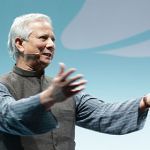
Sharing this summarized article from onlinecollege.org.
While it is admirable to build a successful business of any kind, some entrepreneurs do more than just make a profit with the fruits of their labor. Some actually help others, bringing resources, opportunities, training, and other assets to those who need them most. These social entrepreneurs use their know-how and business savvy to make the world a better place, combining a traditional business model with a pressing social mission in ways that have been helping to make big changes in places around the world for decades. Here, we highlight just a few of the standout social entrepreneurs who’re showing that successful businesses don’t have to just watch the bottom line and can truly be socially and environmentally conscious.
Bill Drayton:
Bill Drayton isn’t just a great example of a social entrepreneur, he actually helped to define and promote the term itself. Drayton is the founder and current chair of Ashoka: Innovators for the Public, an organization that is dedicated to finding and helping social entrepreneurs around the world. Drayton spreads out his social entrepreneurship expertise in other organizations as well, working as a chairman at Community Greens, Youth Venture, and Get America Working! in addition to his duties at Ashoka. As of 2010, Ashoka Foundation has sponsored 2,145 fellows in 73 countries, some of which have gone on to develop leading social businesses that have made a huge impact on communities around the world.
Muhammad Yunus:
Bring up social entrepreneurs and one of the first names you’re likely to encounter is that of Muhammad Yunus. Yunus has quite literally written the book on social entrepreneurship, sharing his expertise in microfinance and social capitalism through a number of books. Yunus is the founder of the Grameen Bank, an institution that provides microcredit loans to those in need to help them develop financial self-sufficiency. Founded in 1983, the bank has brought in a net income of more than $10 million, and his work with the organization landed Yunus a Nobel Prize in 2006.
Blake Mycoskie:
TOMS founder Mycoskie makes this list because, unlike many of these other ventures, almost everyone with an awareness of pop culture has heard of this social brand. Its popularity has spread like wildfire, which is a good thing both for Mycoskie and for the people that TOMS aims to help. Mycoskie founded TOMS in 2006 after a visit to Argentina where he learned that many children get sick or injured because they do not have shoes to wear. To combat this, he created TOMS, a business that donates one pair of shoes to needy people for every pair that’s bought. So far, the company has donated more than a million pairs of shoes. In 2011, the company launched another initiative which aims to give away a pair of glasses or sight-saving surgery for every pair of sunglasses or glasses sold.
Scott Harrison:
Lack of clean and accessible drinking water is sadly something that millions of people (some estimates put it at more than a billion) worldwide face every day. After a moment of clarity in Liberia, club promoter Scott Harrison decided to make it his mission to change that, heading up the non-profit organization charity: water. Since it began, the charity has delivered clean drinking water to more than a million people in 17 different countries around the world. Harrison is perhaps one of the most successful social entrepreneurs of all time, with his organization growing more than 100% in the first quarter of 2011, despite a major economic crisis that paralyzed many similar ventures. Harrison says he regards charity: water as a for-profit startup that has no profits, saying, “We give away 100% of our profits. Our shareholders are people in 17 countries around the world waiting for a rig to drive into a village and provide clean water to a few hundred people living there. We use the word business so much more than nonprofit, even though that’s what we are.” The model seems to be working for him, and Harrison has quickly created a new model for social entrepreneurs to emulate.
Jeffery Hollender:
In 1988, Jeffery Hollender founded cleaning, paper, and personal care products company Seventh Generation. The company focuses on producing products that have a reduced environmental impact, avoiding the harsh chemicals that are part of many of today’s leading cleaning and personal care products. In addition, the company donates 10% of pre-tax profits to funding nonprofits and businesses focused on the community, the environment, and responsible practices. Despite adhering to practices that many businesses claim limit profits, Hollender and his associates have built Seventh Generation into a major corporate force, bringing in over $150 million in revenue in 2010. Hollender was pushed out of his role at Seventh Generation in 2010, but that doesn’t mean he’s slowed down in social entrepreneurship. He helps with the American Sustainable Business Council, writes books on responsible business practices, and is a member of the Social Venture Network and founder of the Community Capital Bank.
Xavier Helgesen, Chris Fuchs, and Jeff Kurtzman:
B corporation Better World Books is an amazing example of a truly successful social entrepreneurship venture. Founded in 2002 by Notre Dame grads Xavier Helgesen, Chris “Kreece” Fuchs, and Jeff Kurtzman, Better World’s mission is to maximize the value of every book out there and to help promote literacy around the world. The company works by reusing or recycling books through sales on their website and donations to schools, and so far has used 84 million volumes to raise $12.1 million for literacy funding. The company attributes its success to using a “triple bottom line” model, caring not only about profits but also about the social and environmental impact of everything they do.
Akhtar Hameed Khan:
One of the pioneers of the now thriving microfinance world was Akhtar Hameed Khan, the dedication to which and his activism in developing rural communities in Pakistan earned him a nomination for the Nobel Prize. Two of Khan’s most major projects during his life were the Comilla Cooperative Project and the Orangi Pilot Project. The Comilla Cooperative aimed to build local infrastructure in rural communities while also helping businesses grow through microfinance initiatives. It would ultimately be unsuccessful, but would be a major learning experience for Khan as he would move on to other projects, including Orangi. In contrast to Comilla, the Orangi Pilot Project would be quite successful, helping a squatter community solve their own problems with sanitation, health, and housing, while offering microfinance, education, and family planning. Some aspects of Khan’s plan are still in use today in areas all over Karachi.
Ibrahim Abouleish:
Early in his career, Ibrahim Abouleish was working in leading pharmaceutical firms in Europe, developing new treatments for osteoporosis and arteriosclerosis, but a trip to Egypt in the mid-’70s would change that. He would leave Europe and move back to Egypt, founding the development initiative SEKEM (Ancient Egyptian for “vitality from the sun”). Abouleish hoped that by using biodynamic farms, schools and vocational training centers, a medical center, and trading company that he could not only help repair the environment but also the lives of the Egyptian farmers in those areas. SEKEM grows plants that are developed into herbal teas, fresh produce, and even organic cotton, which helps to sustain the other facilities it hosts. Abouleish has also played a key role in developing new chemical-free methods to process cotton and developing Egypt’s first private pharmaceuticals company. His business has been so successful that experts and ideas from it are being exported to South Africa, India, Palestine, Senegal, and Turkey.
Willie Smits:
Microbiologist Willie Smits never really expected to become a social entrepreneur, but when he found an abandoned baby orangutan in 1989 while working in Indonesia, his career would quickly alter direction. Smits’ work with orangutans would blossom into the Borneo Orangutan Survival Foundation, which not only works to help orphaned or imperiled apes, but also helps locals learn sustainable farming methods and the benefits of reforestation. Smits also takes part in the Masarang Foundation, an amazingly innovative social entrepreneurship enterprise that uses thermal energy to turn sugar palm juice into sugar and ethanol, providing jobs and power to the community while preserving the local forests. In recognition for his work, Smits has received knighthood in his native Netherlands as well as an Ashoka Fellowship and a variety of other conservation-based awards.
Bunker Roy:
Indian social activist and entrepreneur Sanjit “Bunker” Roy has helped thousands of people in Asia and Africa learn vital technical skills and bring solar power to their sometimes remote villages. Roy founded the Barefoot College, an organization which specializes in teaching illiterate women from poor villages how to become doctors, engineers, and architects. What’s more impressive is that each of the college’s campuses are solar powered and often built and designed by former students. In founding the college, Roy’s goal wasn’t to make a profit for himself, but to help improve the economic production and quality of life of women throughout his native India (though some aspects of the project have spread to Africa as well). With women leading and running most of the Barefoot College’s operations, it’s clear that he’s been pretty successful in achieving that goal.
[image error]
June 30, 2012
What Is Your Social Media Content Saying About You?

Have you checked the pulse of your social media campaigns lately? Many businesses today – large and small – are still getting it wrong; still missing the point of creating engaging content and sharing it with their customer base across multiple channels.
The potential advantages gained from social media marketing are numerous. According to the 2012 Social Media Marketing Industry Report, 85% of marketers reported that social media marketing is boosting business exposure. The report, which was sponsored by the online magazine Social Media Examiner, also found that 58% of marketers listed lead generation as a benefit of social media.
For businesses that hope to enjoy a Return on Investment for their content and social strategies, there are some common pitfalls to avoid:
Actually Have a Strategy
It’s not enough to have a Facebook or Twitter account for your business. The social networks only work if you have focused and relevant messages for your targeted audience. Before even opening a social media account you should have a content strategy developed.
Ask yourself these questions: Who are your audience members? Where do they hang out? (Hint: there are other social hubs besides Twitter and Facebook.) How can you interact with audience members in a way that doesn’t force your brand message on them but rather adds value to their lives in the form of useful and engaging information?
Only when you can answer these questions does it make sense to begin a campaign.
Have the Right People at the Helm
Some businesses assume that the youngest person on staff should be in charge of a social media campaign because so-called “digital natives” are usually a driving force of all things social. Such thinking is skewed.
Your campaign should be in the hands of people who understand the holistic nature of social marketing. It is not about tweeting 20 times a day but rather a case of aligning your brand message across multiple channels that each serves the goal of customer engagement.
A social media campaign can demand a large investment of time and resources. Almost 60% of marketers spend six hours or more a week on social media and a third spend 11 hours or more, according to the Social Media Marketing Industry Report.
If an in-house marketing team can’t handle the job then by all means consider bringing in someone who can.
Don’t Assume You Know the Customer’s Needs
Instead of assuming you know everything there is to know about your customers’ wants and needs – and building social media campaigns around those assumptions – first take the time to get to know your prospects.
Remember that prospects are human beings. Listen to the conversations they’re having on the many digital platforms. Take part in these conversations and engage them. By knowing who your prospects really are, you’ll be much better able to serve them.
Embrace New Metrics and Paradigms
In order to gauge whether your social media campaign is successful or not you need to track the results. But you can’t rely on antiquated metrics. Although many aspects of doing business still revolve around the theory that everything’s a “numbers game,” this rule simply isn’t enough in the realm of social media.
Whether it’s about newsletter subscribers or Twitter followers, it’s important to focus on quality and not just quantity. It’s more profitable to have only 300 Twitter followers if those people actually engage with your message and convert into sales.
So stop thinking numbers and start thinking results.
There’s no question that a social media strategy is no longer an option for most businesses – it’s a requirement for survival. According to an August 2011 report by the Pew Internet & American Life Project, 65% of adult Internet users are using a social networking site, up from 29% in 2008.
In addition, 94% of respondents in the 2012 Social Media Marketing Industry Report said they were using social media for marketing purposes and 83% said it was important for their business.
However, approaching a social media campaign with the wrong mindset – and without any preparation – can be detrimental in the long run. So, avoid the common pitfalls and take the time to formulate a strategy that works for your business’ specific needs and market.
Photo provided by tadahsocialmedia.com
This guest post was provided by Jessica Edmondson who writes about social media training and internet marketing training for the University Alliance, a division of Bisk Education, Inc.
[image error]
June 28, 2012
Five Killer Strategies to Dominate Social Media’s Big 3: Facebook, Twitter and YouTube

There is no doubt that the social media landscape is dominated by the Big 3 platforms – Facebook, Twitter, and YouTube. Facebook alone boasts over 800 million users, 50 percent of whom log in daily. Over 250 million tweets are posted each day on Twitter, and YouTube is now touted as the second largest search engine, serving over 4 billion videos daily. You may think that social media marketing on each of the Big 3 platforms should be done differently, but in fact there are five ways you can approach social marketing across these platforms that will help you get the most out of your efforts.
To be successful across the Big 3, consider the following five killer strategies:
Strategy One: Increase your social reach
Social reach is all about engaging with a growing number of fans and followers with the right presence in the right social channels. On Facebook, that means having a killer Timeline image. Follow what the pros do – for example, Jackson Kayak, the innovative maker of kayaks, asked fans to submit action photos as part of a Facebook contest and then encouraged fans to ‘Like’ their favorite photo submissions. The winning photo was used as their cover Timeline image.
Strategy Two: Increase Fan Engagement with Content
In social media, content is indeed the king. A recent McKinsey Quarterly study revealed that having the ability to engage customers and leverage those relationships is the top digital challenge marketers face today. Engage your fans and followers with funny, emotional, controversial, or empathetic posts– aim for striking a chord with your followers. Above all, be genuine – post that which is in line with your brand voice and relevant to your audience. Learn from those who do this best – for example, Orabrush used funny videos to connect with their fans. The company, who makes tongue cleaners, developed a series of short, highly entertaining videos including one that plays out like a suspenseful thriller preview and others that feature a spokesperson dressed as a tongue. Their YouTube channel boasts nearly 50 million views and is chock full of funny skits. Their success on YouTube helped them secure distribution in Walmarts nationwide.
Strategy Three: Increase Lead Generation
Lead generation on social channels is different from traditional lead generation – it’s rarely appropriate to simply push a sales message. Successful lead generation on social media requires marketers to think more like a social customer and less like a marketer or salesperson. Keep leading social psychologist Robert Cialdini’s Theory of Reciprocity in mind – be helpful – don’t sell to prospects – help them solve a problem, even if it means recommending another solution. Show them you care about what your prospects care about. Monitor social media conversations, respond fairly to criticisms, answer questions and spread accolades.
For instance, 8th Continent Soymilk monitored buzz about a competitor and offered coupons to dissatisfied customers. The online coupons, distributed via social channels including Twitter, earned a 39% redemption rate, compared to a 0.7% redemption rate of physical coupons.
Strategy Four: Identify and Engage Influencers
Influence, both internal and external to a brand, can be leveraged to spread awareness of your brand and fuel word-of-mouth for brand advocacy and sales. Leverage internal influencers by segmenting customers by need, engaging them in targeted campaigns and rewarding them for performing desired actions. Reward your brand advocates for doing what they do best – create marketing campaigns that drive each segment to do more of what they already do for you.
For connecting with influencers external to your brand, you can use a multitude of tools including Traackr, PeekYou, Klout, Kred by peoplebrowsr, mBlast and PeerIndex. Be sure to avoid the popularity pitfall – targeting an influencers based on their number of followers even though their focus is not relevant to your audience.
Strategy Five: Apply Analytics to Know What Works
Use analytics to measure success by social channel and content type. Analytics will help you understand the growth of followers, if your content is engaging, if external influencers and brand advocates are supporting you, and if you are driving leads and sales. It’s important to measure each and every campaign to continuously optimize the return on your efforts.
Want to know more about the five killer ways to engage with your fans and followers on the Big 3? Consult with our free e-book Five Killer Strategies to Dominate Social Media’s Big 3: Facebook, Twitter and YouTube.
Marketers, now onto you! Which companies do you try to emulate? Where have you seen great return on your social efforts? What are your top strategies for conquering the Big 3? Share your thoughts and best practices with our community on Twitter.
[image error]






